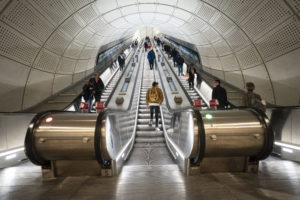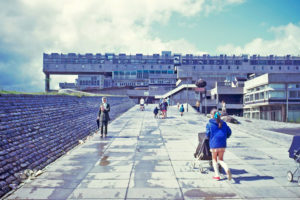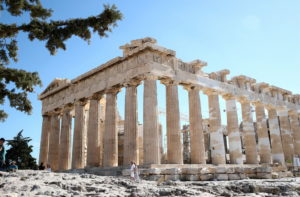Ask a conservative why Britain’s cities and towns often look so ugly, and you’ll likely be told that it’s intentional: the result of post-war utopianism and the establishment’s inexplicable embrace of modernist architecture. For the traditionalist magus, Roger Scruton, such a development was “the greatest crime against beauty the world has yet seen”. In this account, it is the fanatical architect, zealous planner, and toadyish politician who are to blame for the handsome streets of yesteryear giving way to atomised ruin. The malaise may be aesthetic, but its roots are moral.
What is not asked, however, is why? Why did Britain, and much of the West, suddenly insist on remaking the built environment at such speed? The idea this resulted from a sudden bout of cultural self-loathing is supported by no evidence. The same is true for the notion that despite founding Nato and trying to maintain its empire, post-war Britain was somehow stuffed with surreptitious Marxists, from the commanding heights of Westminster to the planning offices of your local town hall.
Like most simple, comforting stories, this is wrong — a convenient narrative for inaction and self-satisfied moaning. What is needed instead is a Marxist, materialist account of why the built environment changed as it did. History, after all, is not forged purely by ideas.
What does a materialist analysis tell us? Firstly, that conservative concepts of beauty are incongruent with a devotion to the free market, something which Marx identified 150 years ago. Capitalism, driven by a relentless quest for profit, requires constant spatial transformation. This means we have the buildings we do because, for the most part, somebody somewhere is making a buck. This is difficult to grasp for many on the Right because they have elevated profit into a kind of ethical value (although this wasn’t always the case). But it should be relatively obvious, and far less outlandish than the idea that your nearest Wilko or TK Maxx looks the way it does because of the malevolent influence of Oscar Niemeyer. As Marx wrote in The Communist Manifesto: “All that is solid melts into air; all that is holy is profaned.” This is why a commitment to the free market, and to social and aesthetic conservatism, are irreconcilable.
This is most conspicuous today with Purpose Built Student Accommodation (PBSAs), those modular ziggurats afflicting skylines across Britain, from Altus House in Leeds to Beckley Point in Plymouth (each is the tallest building in their respective city). In Cardiff, more than 7,000 student “flats” were built in just three years.
These buildings are springing up like medieval Bolognese towers for two reasons: firstly, because the building standards are lower for student developments than either residential housing or housing in multiple occupation; and secondly, because building them is lucrative. Forget Marxist council officers and architects with fantasies of becoming the next Frank Gehry. These buildings are being assembled in the quest for profit.
In Portsmouth, the city centre has now essentially become a student campus, the city’s sense of civic pride sacrificed to corporate student accommodation and fast-food outlets zipping deliveries to them via smartphone. It’s a grim vision of what our smaller city centres are becoming, with spaces for interaction in short supply. In Bournemouth, where I grew up, a seaside town synonymous with Victorian and Art Deco architecture looks increasingly like the set of the Teletubbies. Any sense of place is out of the question, the objective instead being to turn the town into a giant airport terminal.
Another important reason for those tragic “before and after” pictures so beloved of Trad Architecture Twitter is the popular adoption of the car in the mid-20th century. As with the failure to grasp the contradiction between free markets and conservation, this too is lost for many on the Right (although, in his defence, Scruton once referred to cars as “dangerous weapons”). This shouldn’t be overly surprising given the automobile was synonymous with personal freedom, an avatar of the sovereign individual conquering the elements. What is forgotten with this blanket projection of personal autonomy, detached from society, is that the dense patchwork of urban settlement that preceded it was lost. You may be able to go anywhere in a car, but you do so by cutting yourself off from others. In the words of Kafka: “you are free, and that is why you are lost.”
The reconfiguration of streets around the car is the principal reason cities such as Birmingham, Glasgow and Bristol lost much of their lustre. This was not limited to Britain, of course. Take the story of Robert Moses, the subject of Robert Caro’s magnificent biography The Power Broker. Over several decades as a public official in New York, Moses gleefully destroyed downtown areas often marked by cultural and racial diversity, as well as high density construction. The reason? To build expressways.
The Cross Bronx Expressway offers the best example of this, ripping as it did through the heart of what would become the northern and southern parts of the Bronx. Things could have been worse, however. And it was only because of civic resistance, led by the likes of Jane Jacobs, that the construction of the proposed Lower Manhattan Expressway was stopped. Had she failed, it would have destroyed much of what is SoHo, Little Italy and Chinatown.
While it’s true that an infatuation with the car was central to post-war planning, today it is the Left leading the movement for low traffic neighbourhoods (LTNs). By contrast, it is Conservative councils, such as in Southampton or Wandsworth, that are reversing them. This is not to say all LTNs have been executed well, but it is clear that reducing our dependence on cars has become a part of the culture wars, with conservatives often on the wrong side. It’s one thing posting nostalgic pictures of yesteryear; it’s another to do the hard political yards to reverse mistaken choices since.
This bizarre confusion is most obvious in Poundbury, the experimental community built on land belonging to Prince Charles. Even here, in a place whose premise is a return to tradition, the civic centre of Queen Mother Square is a car park. Even if you embrace the orthodoxies behind the project (I personally find it more akin to a Las Vegas theme park), it’s hard to see how rows of hatchbacks and people carriers continue the legacy of Victorian or Georgian architecture. It’s the same in the village of Wickham, home to the second largest medieval square in England. The Visit Hampshire website refers to the village’s “15th century cottages” and “beautifully preserved Georgian houses”. Yet such wonders are also now obscured by the fact that the village square is now a rather large car park.
When it comes to the built environment, it’s easy to lapse into mistaken binaries. On the Right, conservatives wish to retain a distinctive architecture. They claim to want to “conserve” buildings whose qualities transcend present, fleeting sensibilities. They believe in objective standards of beauty — be they from antiquity, or the work of Palladio or Wren. The Left, meanwhile, is apparently driven by a fixation with the future, a permanent experimentation with forms and an impulse to discard the old.
And yet much of this narrative doesn’t align with reality. Councils of all stripes are gleefully granting permission for hideous student blocks, while a Conservative government oversees our rivers being pumped with effluent. Meanwhile, it is progressives who make the arguments for more humane environments where we use our cars less and enjoy a slower pace of life. They don’t always get everything right, but there should be no doubt that active travel, living streets and low traffic neighbourhoods are the simplest ways to begin making our towns and cities beautiful again.
All of which is why the socialist case for respecting architectural heritage should not be at odds with a small ‘c’ conservative approach. This should be the opposite of the promethean road-building projects of the last century, while also avoiding a swivel-eyed hatred of more recent architectural heritage, whether that be the Barbican in London or Berlin’s Palace of the Republic. Take the brutalist Trinity car park in Gateshead. Conservative critics may think such buildings shouldn’t exist by default, and so it was demolished in 2010. Yet it has been replaced by a Tesco — hardly a win for Scrutonian beauty and the public good.
Finally, socialists and conservatives alike must understand that the built environment, as with every human endeavour, is an inheritance from one generation to the next. We should be humble rather than dismiss the ideas of those before us, regardless of which century they come from, while also asking what kinds of structures will fill our descendants with wonder. As Stephen Nachmanovitch wrote: “If we operate with a belief in long sweeps of time, we build cathedrals. If we operate from fiscal quarter to fiscal quarter, we build ugly shopping malls.” The enemy of beauty isn’t “modernism”; it’s a society built on maximising profit and shareholder value.
Disclaimer
Some of the posts we share are controversial and we do not necessarily agree with them in the whole extend. Sometimes we agree with the content or part of it but we do not agree with the narration or language. Nevertheless we find them somehow interesting, valuable and/or informative or we share them, because we strongly believe in freedom of speech, free press and journalism. We strongly encourage you to have a critical approach to all the content, do your own research and analysis to build your own opinion.
We would be glad to have your feedback.
Source: UnHerd Read the original article here: https://unherd.com/




